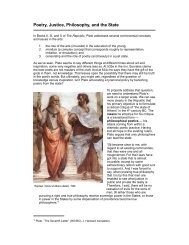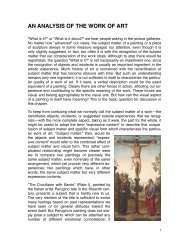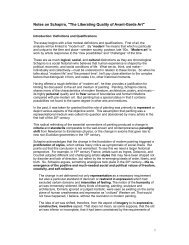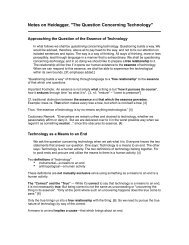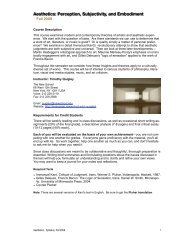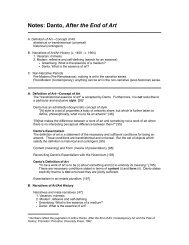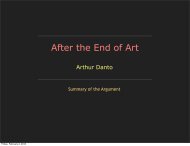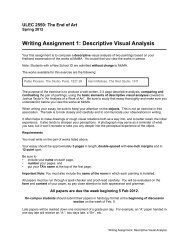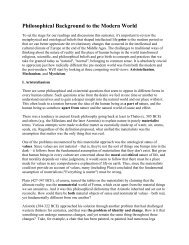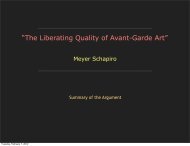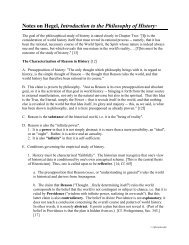You also want an ePaper? Increase the reach of your titles
YUMPU automatically turns print PDFs into web optimized ePapers that Google loves.
our eyes, <strong>and</strong> thence upon our brain, does not resemble the visible world any more thanetchings do. Nothing goes from things to the eyes, <strong>and</strong> from the eyes to vision, no morethan from things to a blind man's h<strong>and</strong>s, <strong>and</strong> from his h<strong>and</strong>s to his thoughts.Vision is not the metamorphosis of things themselves into the sight of them; it is not amatter of things' belonging simultaneously to the world at large <strong>and</strong> a little private world. Itis a thinking that unequivocally decodes signs given within the body. Resemblance is theresult of perception, not its basis. Thus, the mental image, the visualization which renderspresent to us what is absent, is a fortiori nothing like a breakthrough to the heart of Being.It too is a thought relying upon bodily indices—this time insufficient ones—which aremade to say more than they mean. Nothing is left of the oneiric world of analogy….“[E]very theory of painting is ametaphysics.”painting vs. drawingDiscussion of depth in image <strong>and</strong>perception.What interests us in these famous analyses is that they make us aware of the fact thatevery theory of painting is a metaphysics. Descartes does not say much about painting,<strong>and</strong> one might think it unfair on our part to make so much of a few pages on engravings.And yet the very fact that he speaks of painting only in passing is itself significant.Painting for him is not a central operation contributing to the definition of our access toBeing; it is a mode or a variant of thinking, where thinking is canonically defined asintellectual possession <strong>and</strong> self-evidence. His very brevity is the indication of a choice; acloser study of painting would lead to a different philosophy. It is significant, too, thatwhen he speaks of "pictures" [tableaux] he takes line drawings as typical. We shall seethat the whole of painting is present in each of its modes of expression; there is a kind ofdrawing, even a single line, that can embrace all of painting's bold potential.But what Descartes likes most about engravings is that they preserve the form of objects,or at least give us sufficient signs of their forms. They present the object by its outside, orits envelope. If he had examined that other, deeper opening upon things given us by thesecondary qualities, especially color, then—since there is no rule-governed or projectiverelationship between them <strong>and</strong> the true properties of things, <strong>and</strong> we underst<strong>and</strong> theirmessage all the same—he would have found himself faced with the problem of aconceptless universality <strong>and</strong> opening upon things. He would have been obliged to findout how the uncertain murmur of colors can present us with things, forests, storms—inshort the world. He would have been obliged, perhaps, to integrate perspective, as aparticular case, into a broader ontological power. But for him it goes without saying thatcolor is an ornament, mere coloring, <strong>and</strong> that the real power of painting lies in drawing,whose power in turn rests upon the ordered relationship between it <strong>and</strong> objective spaceestablished by perspectival projection. Pascal's famous saying that painting is frivolousbecause it attaches us to images whose originals would not move us is a Cartesiansaying. For Descartes it is self-evident that one can paint only existing things, that theirexistence consists in being extended, <strong>and</strong> line drawing alone makes painting possible bymaking possible the representation of extension. Thus painting is only an artifice that putsbefore our eyes a projection similar to the one things themselves would (<strong>and</strong> do,according to the commonsense view) inscribe in them. Painting causes us to see, withoutreal objects, just as we see things in everyday life; <strong>and</strong> in particular it makes us seeempty space where there is none.[22]The picture is a flat thing contriving to give us what we would see in the presence of"diversely positioned" things, by offering sufficient diacritical signs, through height <strong>and</strong>width, of the missing dimension.[23] Depth is a third dimension derived from the othertwo.It will be worth our while to dwell for a moment upon this third dimension. There is, at firstglance, something paradoxical about it. I see objects that hide each other <strong>and</strong> thatconsequently I do not see; each one st<strong>and</strong>s behind the other. I see depth <strong>and</strong> yet it is notvisible, since it is reckoned from our bodies to things, <strong>and</strong> we are [as Cartesians]confined to our bodies. There is no real mystery here. I do not really see depth or, if I do,it is only another size. On the line from my eyes to the horizon, the foreground foreverhides all the other planes, <strong>and</strong> if on either side I think I see things staggered at intervals,8



